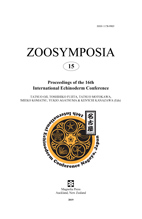Abstract
Recent efforts to reconstruct the phylogeny of brittle stars (ophiuroids) have shown the need for more objective and reproducible data collection methods than the traditional visual examination and verbal description of morphological characters. Complex skeletal structures may be better understood in three dimensions than in two dimensions obtained from techniques like scanning electron microscopy (SEM). We test this hypothesis using three types of three-dimensional tomographic imaging methods—lab-based micro-CT, X-ray microscopy and synchrotron-based tomography—to examine the morphology of ophiuroid arms, and compare them with two-dimensional data obtained from SEM. We describe the advantages and disadvantages of each instrument and set of parameters in terms of the ease and efficiency of data collection for morphometric analyses. We present new morphological observations obtained by digital sectioning of three-dimensional images that could not be achieved with SEM. Overall, our findings suggest that three-dimensional imaging has a high potential to address the gaps in knowledge of the internal ophiuroid skeleton, which will be pivotal to providing morphological characters that will aid in phylogenetic reconstructions.

